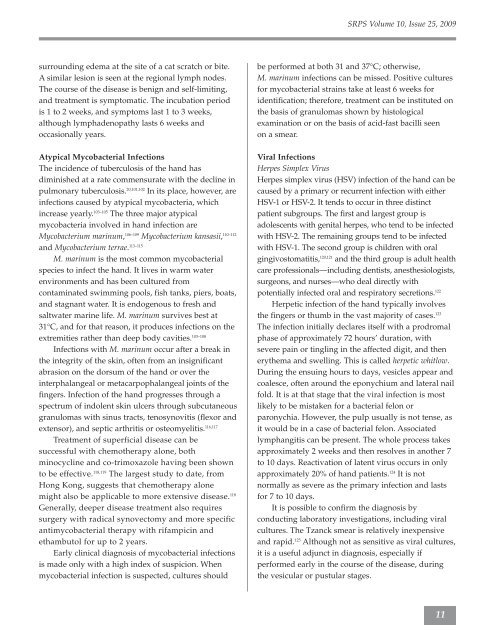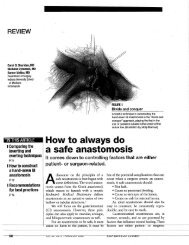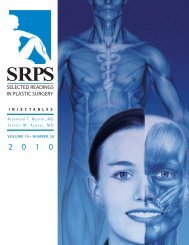SRPS PS - Plastic Surgery Internal
SRPS PS - Plastic Surgery Internal
SRPS PS - Plastic Surgery Internal
Create successful ePaper yourself
Turn your PDF publications into a flip-book with our unique Google optimized e-Paper software.
surrounding edema at the site of a cat scratch or bite.<br />
A similar lesion is seen at the regional lymph nodes.<br />
The course of the disease is benign and self-limiting,<br />
and treatment is symptomatic. The incubation period<br />
is 1 to 2 weeks, and symptoms last 1 to 3 weeks,<br />
although lymphadenopathy lasts 6 weeks and<br />
occasionally years.<br />
Atypical Mycobacterial Infections<br />
The incidence of tuberculosis of the hand has<br />
diminished at a rate commensurate with the decline in<br />
pulmonary tuberculosis. 20,101,102 In its place, however, are<br />
infections caused by atypical mycobacteria, which<br />
increase yearly. 103–105 The three major atypical<br />
mycobacteria involved in hand infection are<br />
Mycobacterium marinum, 106–109 Mycobacterium kansasii, 110–112<br />
and Mycobacterium terrae. 113–115<br />
M. marinum is the most common mycobacterial<br />
species to infect the hand. It lives in warm water<br />
environments and has been cultured from<br />
contaminated swimming pools, fish tanks, piers, boats,<br />
and stagnant water. It is endogenous to fresh and<br />
saltwater marine life. M. marinum survives best at<br />
31°C, and for that reason, it produces infections on the<br />
extremities rather than deep body cavities. 103–108<br />
Infections with M. marinum occur after a break in<br />
the integrity of the skin, often from an insignificant<br />
abrasion on the dorsum of the hand or over the<br />
interphalangeal or metacarpophalangeal joints of the<br />
fingers. Infection of the hand progresses through a<br />
spectrum of indolent skin ulcers through subcutaneous<br />
granulomas with sinus tracts, tenosynovitis (flexor and<br />
extensor), and septic arthritis or osteomyelitis. 116,117<br />
Treatment of superficial disease can be<br />
successful with chemotherapy alone, both<br />
minocycline and co-trimoxazole having been shown<br />
to be effective. 118,119 The largest study to date, from<br />
Hong Kong, suggests that chemotherapy alone<br />
might also be applicable to more extensive disease. 118<br />
Generally, deeper disease treatment also requires<br />
surgery with radical synovectomy and more specific<br />
antimycobacterial therapy with rifampicin and<br />
ethambutol for up to 2 years.<br />
Early clinical diagnosis of mycobacterial infections<br />
is made only with a high index of suspicion. When<br />
mycobacterial infection is suspected, cultures should<br />
<strong>SR<strong>PS</strong></strong> Volume 10, Issue 25, 2009<br />
be performed at both 31 and 37°C; otherwise,<br />
M. marinum infections can be missed. Positive cultures<br />
for mycobacterial strains take at least 6 weeks for<br />
identification; therefore, treatment can be instituted on<br />
the basis of granulomas shown by histological<br />
examination or on the basis of acid-fast bacilli seen<br />
on a smear.<br />
Viral Infections<br />
Herpes Simplex Virus<br />
Herpes simplex virus (HSV) infection of the hand can be<br />
caused by a primary or recurrent infection with either<br />
HSV-1 or HSV-2. It tends to occur in three distinct<br />
patient subgroups. The first and largest group is<br />
adolescents with genital herpes, who tend to be infected<br />
with HSV-2. The remaining groups tend to be infected<br />
with HSV-1. The second group is children with oral<br />
gingivostomatitis, 120,121 and the third group is adult health<br />
care professionals—including dentists, anesthesiologists,<br />
surgeons, and nurses—who deal directly with<br />
potentially infected oral and respiratory secretions. 122<br />
Herpetic infection of the hand typically involves<br />
the fingers or thumb in the vast majority of cases. 123<br />
The infection initially declares itself with a prodromal<br />
phase of approximately 72 hours’ duration, with<br />
severe pain or tingling in the affected digit, and then<br />
erythema and swelling. This is called herpetic whitlow.<br />
During the ensuing hours to days, vesicles appear and<br />
coalesce, often around the eponychium and lateral nail<br />
fold. It is at that stage that the viral infection is most<br />
likely to be mistaken for a bacterial felon or<br />
paronychia. However, the pulp usually is not tense, as<br />
it would be in a case of bacterial felon. Associated<br />
lymphangitis can be present. The whole process takes<br />
approximately 2 weeks and then resolves in another 7<br />
to 10 days. Reactivation of latent virus occurs in only<br />
approximately 20% of hand patients. 124 It is not<br />
normally as severe as the primary infection and lasts<br />
for 7 to 10 days.<br />
It is possible to confirm the diagnosis by<br />
conducting laboratory investigations, including viral<br />
cultures. The Tzanck smear is relatively inexpensive<br />
and rapid. 125 Although not as sensitive as viral cultures,<br />
it is a useful adjunct in diagnosis, especially if<br />
performed early in the course of the disease, during<br />
the vesicular or pustular stages.<br />
11






